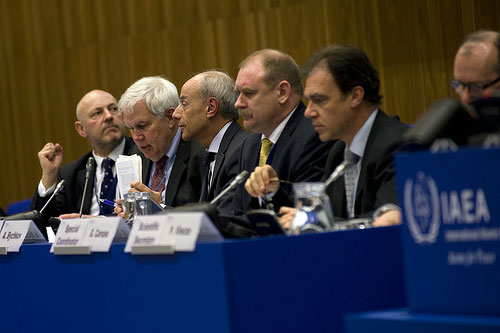UN atomic agency releases report of new Japan nuclear safety measures
The United Nations atomic energy agency today delivered its review of Japan’s revised nuclear safety assessment process a year after the country was shaken by one of the world’s worst nuclear accidents at the Fukushima Daiichi power plant.

International experts meeting on reactor and spent fuel safety in light of the accident at the Fukushima Daiichi Nuclear Power Plant.
The review was undertaken by a team of eight UN International Atomic Energy Agency (IAEA) experts who visited the country in January at the request of the Japanese Government.
“I hope nuclear regulators around the world use this report as a tool to evaluate their own safety assessment processes,” said the team’s leader, the Director of the IAEA’s Nuclear Installation Safety Division, James Lyons, who added that the new Japanese measures were “generally consistent” with the IAEA’s safety standards.
In March 2011, the Fukushima Daiichi nuclear power plant was severely damaged during a massive earthquake and tsunami that struck the Japanese coastline. The building housing the plant exploded and three of its nuclear reactors suffered a meltdown in what was reported to be the worst nuclear accident since the 1986 Chernobyl disaster. A year later, a 19-kilometre exclusion zone still surrounds the disaster site.
“We must learn the lessons of the Fukushima Daiichi accident so we can prevent a repeat of those terrible events a year ago,” Mr. Lyons said.
During their mission, the review team held meetings in Tokyo with a number of officials from Japan’s nuclear sector and visited the Ohi Nuclear Power Station for an overview of how Japan’s compliance with nuclear safety monitoring – known as the Comprehensive Safety Assessment – is being implemented by nuclear operators.
In their report, the IAEA team highlighted good practices while also identifying improvements that would enhance the overall effectiveness of Japan’s Comprehensive Safety Assessment process.
The mission also noted that all upgrades aimed at increasing the safety margins against seismic and tsunami hazards should be studied by the relevant local authorities and checked against the IAEA Safety Standards, a system of fundamental principles and requirements for ensuring safety.
The report’s release comes on the heels of a two-day Nuclear Security Summit held in Seoul, in the Republic of Korea, during which global nuclear security and safety were discussed by world leaders.
Source: UN NEWS
- 431 reads
Human Rights
Ringing FOWPAL’s Peace Bell for the World:Nobel Peace Prize Laureates’ Visions and Actions

Protecting the World’s Cultural Diversity for a Sustainable Future

The Peace Bell Resonates at the 27th Eurasian Economic Summit

Declaration of World Day of the Power of Hope Endorsed by People in 158 Nations

Puppet Show I International Friendship Day 2020

